By KEVIN WEAKS
2020 Stingray is the fastest, most powerful

The first Corvette was based on a 1952 General Motors auto show “dream car,” as concept cars were called then. It got such good reception that GM decided to build it. Named after the speedy WWII ships, the Corvette arrived in late 1953 with a straight-six Chevrolet engine, Polo White paint and a bright Sportsman Red interior. The 1955 Corvette, which had the same styling as the 1953 model, got Chevy’s 195-horsepower V-8 and could be had with a standard three-speed manual gearbox.
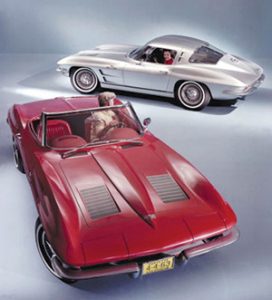
When the next-generation C2 Corvette debuted in 1963, it was called “Sting Ray” after its radical manta ray design. The 1963 Sting Ray also had wider appeal because it offered more comfort features than earlier Corvettes, including power steering, power brakes, AM/FM radio, air conditioning and even leather upholstery. While the first Corvette had only 315 buyers in 1953, sales of the new Sting Ray soared to 21,513 cars.
The Sting Ray had a wide variety of horsepower ratings and options, and finally got disc brakes in 1965 to handle the power of larger, more powerful V-8s, including a 396-cubic-inch “Turbo Jet” engine with 425 horsepower, introduced for 1965. “Sting Ray” became Stingray for the 1969 model year and the third-generation C3 Corvette continued with the name through 1976. The name was then retired until 2013.
PUSHING THE BOUNDARY
“Corvette has always represented the pinnacle of innovation and boundary-pushing at GM. The traditional front-engine vehicle reached its limits of performance, necessitating the new layout,” said GM President Mark Reuss at the announcement of the brand’s first-ever production mid-engine Corvette.
That “new layout” moves the Corvette’s engine from the front to a butt-rumbling position right behind the driver.
“In terms of comfort and fun, it still looks and feels like a Corvette, but drives better than any vehicle in Corvette history. Customers are going to be thrilled with our focus on details and performance across the board,” said Reuss.
The 2020 Stingray’s exterior is exotic, but still unmistakably Corvette. It’s lean and muscular.
“As America’s most iconic performance nameplate, redesigning the Corvette Stingray from the ground up presented the team a historic opportunity, something Chevrolet designers have desired for over 60 years,” said Michael Simcoe, vice president of Global Design, General Motors. “It is now the best of America, a new arrival in the mid-engine sports car class.”
It also is the fastest of any entry Corvette ever — 0-60 in under three seconds when equipped with Z51 Performance Package.
GM says the new mid-engine layout gives the 2020 Stingray better weight distribution. It also provides better responsiveness and control due to driver positioning closer to the front axle, almost on top of the front wheels.
The new seating position places the car’s center of gravity close to the driver’s inside hip, so the car literally turns around the driver as he grips the new two-spoke steering wheel. GM says it completely changes the perception of vehicle handling and responsiveness and yields a race car-like view of the road due to lower positioning of the hood, instrument panel and steering wheel.
Oh, and with the engine in the middle, the Corvette now has trunks front and back for a total of 12.6 cubic feet of cargo volume, great for luggage or even two sets of golf clubs.
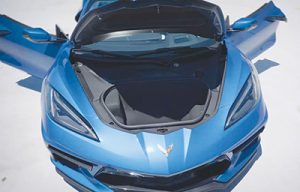
ENGINE IN THE MIDDLE
The all-new Corvette Stingray is built with a mix of diecast aluminum, fiberglass resin and sports an industry-first carbon fiber curved rear bumper beam for weight reduction. But the 2020 Stingray’s heart is Chevy’s next-generation 6.2L Small Block V-8 LT2 engine, the only naturally aspirated V-8 in the segment. It will produce 495 horsepower and 470 lb-ft of torque when equipped with performance exhaust — the most horsepower and torque for any entry Corvette. The motor is visible through a 3.2-millimeter glass pane.
“Though now placed behind the driver, the LT2 gives the same visceral experience we all expect from Corvette,” said Jordan Lee, GM’s global chief engineer of Small Block engines. “The LT2 has been designed to deliver excellent low-end torque and high-end power to give thrilling pedal response at any RPM.”
GM’s Tonawanda, New York, engine plant will build the 6.2L Small Block V-8. Tonawanda employs more than 1,500 people and the hourly workforce is represented by UAW Local 774. Production of the 2020 Corvette Stingray begins at GM’s Bowling Green, Kentucky, assembly plant in late 2019. You might recall that Corvettes were produced right here in St. Louis starting in 1954 until 1981.
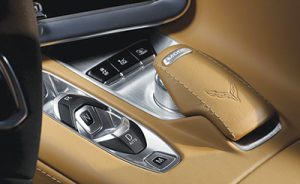
SORRY, NO STICK SHIFT
The V-8 is paired with Chevrolet’s first eight-speed dual-clutch transmission. But don’t look for a manual stick shift. The official word is that the car didn’t need a manual transmission because the C8’s automatic is so dramatically improved. For the first time it is a dual-clutch unit by Tremec. But the real thing that convinced the Chevy team not to offer a manual, opines Car and Driver, was low sales of the stick-shift C7 Corvette.
Chevy says the C8’s steering wheel paddle-actuated tranny is designed to provide the best of both worlds: the hands-on feeling of a manual and the ease of an automatic. The double-paddle de-clutch feature even allows the driver to disconnect the clutch by holding both paddles for more manual control.
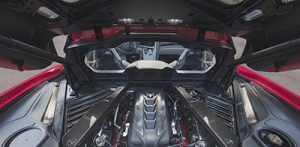
The 2020 Corvette’s interior is a radical departure from the current car’s cockpit. The C7 was already fairly driver-oriented, but the new car takes things further with a long row of buttons separating the passenger seat from the center console and tilted down toward the driver. The C8’s instrument cluster is all digital with a floating 12-inch infotainment screen. The traditional shift lever has been replaced by a set of buttons.
The base 1LT model starts at exactly $59,995, remarkable given its totally new structure and only $3,000 more than the C7 Corvette Stingray.
The 1LT trim level includes a fair number of standard features, including dual-zone climate control, power seats, a 10-speaker Bose audio system, and an 8.0-inch touchscreen with Apple CarPlay and Android Auto.
The better-equipped Corvette 2LT starts at $67,295 and adds desirable extras such as a head-up display, heated and cooled seats, a heated steering wheel, a 14-speaker Bose audio system, navigation, SiriusXM satellite radio, a few driver-assist features, and GM’s Performance Data Recorder system.
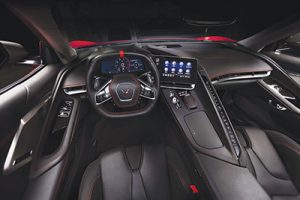
Sitting at the top of the lineup is the 3LT, which starts at $71,945 and includes an upgraded interior with leather, carbon-fiber, and suede trim along with different sport seats that are dubbed GT2.
The Z51 Performance package costs $5,000 extra for any trim level, and it’s a must-have for those intending to take their C8 to the track. It includes a performance exhaust that adds five horsepower and five lb-ft of torque to the Corvette’s 6.2-liter V-8 engine.
The 2020 Corvette Stingray marks a quantum leap for the brand, as well as a calculated risk for GM. Executive chief engineer Tadge Juechter says that the mid-engine C8 Corvette couldn’t be the wild fantasy of the team’s inner adolescents. It had to be a durable design, one with a reasonably long shelf life. It still had to be immediately recognizable as a Corvette, but it couldn’t be retro, because that’s a design dead end. It had to be a sort of homage to 1963; a radical redesign of the shape that opened a new era.
Contact Kevin Weaks at kweaks@labortribune.com

